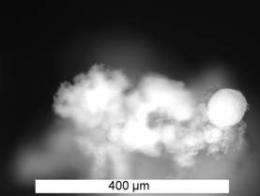Spying on Plastic Production

(������ƵOrg.com) -- Real-time monitoring of high-density polyethylene (HDPE) production is now possible. In an article in the journal Macromolecular Reaction Engineering, Professor Rolf Mülhaupt and his student Rainer Xalter of Albert-Ludwigs University in Freiburg, Germany, describe how they use a combination of laser reflectance measurements and video monitoring to follow the polymerization of ethylene in slurries in standard commercial-scale reactors. They watch the slurries as the plastics grow under different conditions, and are able to use the results to explain variations in efficiency and product range.
Polyethylene is the most widely used plastic today. Also known as polythene or polyethene, it is an integral part of modern life, being used in such items as domestic water pipes, plastic bags, outdoor furniture, and rubbish bins. Being highly recyclable, its applications are likely to increase, so improving efficiency of production is important in this world of limited petrochemical resources. If producers can monitor precisely what is happening inside their reactors, fine-tuning is possible and the product quality is easier to control. The possibility of developing new catalysts and improving current systems is also very real.
HDPE, the most common form of polyethylene, is produced in catalytic slurries. Current methods for monitoring these types of reactions have involved off-line monitoring or the use of special cells without stirring. Stirring is necessary in commercial polyethylene production, but it plays havoc with standard particle monitoring techniques, and it is the particles that must be under constant surveillance if the reaction is to be followed closely.
In slurries, polyolefins (polyethylene is the simplest example) are made using supported Ziegler and metallocene catalysts, which assist the small olefin, or alkene, molecules to break bonds and join together into larger units called polymers. The polymer (or plastic) particles grow on a macroscopic scale as, simultaneously, the catalyst breaks up. According to the authors, “This very complex interplay of polymer particle growth and catalyst particle fragmentation governs polymerization kinetics and as well as polymer particle morphologies and bulk densities.” In gas-phase reactions, optical microscopy has been combined with video to effectively monitor particle growth in-line. Rainer and Mülhaupt have taken this basic idea and developed it to a new level to enable it be applied to stirred slurries, which are far more complex environments to observe.
The new technique involves using a LasentecTM “Particle Vision and Measurement” (PVM) probe developed by Mettler-Toledo GmbH, which, the authors explain, “makes video microscopic images of moving particles technically feasible via CCD camera-mediated imaging using a pulsed light source”, combined with a Lasentec “Focused Beam Reflectance Measurement” (FBRM) probe developed by the same company. The FBRM probe “employs a rotating focused laser beam which is scattered back at individual particles at or close to the focal point of the laser beam.” Mathematical evaluation of the duration and intensity of the backscattered light is used to determine particle size distributions.
As the scientists explain, “While the FBRM technique delivers well-founded statistical data regarding the evolution of the particle size distribution over time, the PVM probe yields high-quality images providing detailed information on size and shape of the particle species being present in the respective stages of the polymerization process.” Methods for correlating the results with reaction kinetics were developed, and results from both probes compared well with those obtained from off-line monitoring for a variety of reaction scenerios. Although only polyethylene was investigated in this paper, application to other polyolefin slurry systems is expected to be straightforward. Application to copolymerization reactions is expected to yield exciting results.
More information: “On-line Monitoring of Polyolefin Particle Growth in Catalytic Olefin Slurry Polymerization by means of LasentecTM Focused Beam Reflectance Measurement (FBRM) and Video Microscopy (PVM) Probes”, R. Xalter and R. Mülhaupt, Macromol. React. Eng. 2010, 4, 25.
Provided by Wiley



















